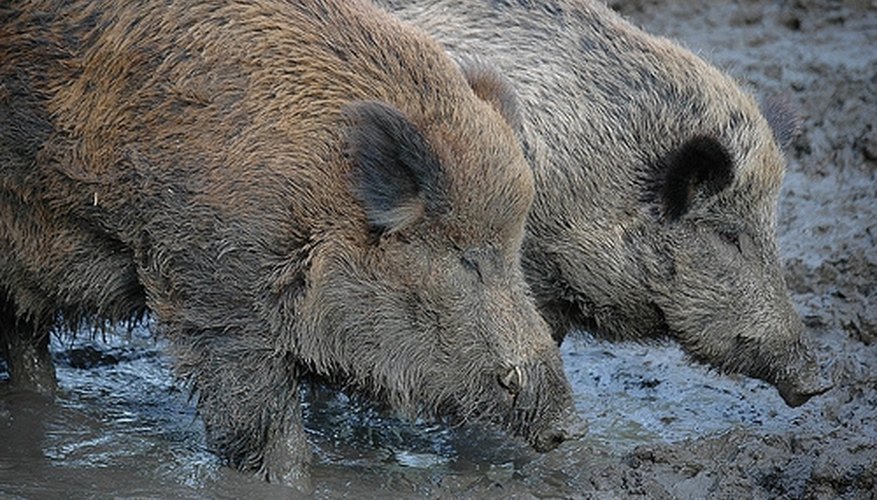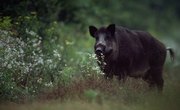
The razorback hog, also called the feral hog or wild boar, is not only the mascot of the University of Arkansas in Fayetteville but also an actual well-known wild animal found throughout Arkansas and neighboring states. In order to understand the hog's natural habitat, it's also important to understand its origins, geography, preferred environment and diet.
History
The razorback hog is thought to be a descendant of domesticated hogs brought to the Americas by early settlers around the16th century. According to the Encyclopedia of Arkansas, these hogs eventually escaped from their pens and bred with their wild counterparts and were from then on called "wild boars." The male hog can weigh up to 300 pounds and measure up to 5 feet, and it receives its name from the stiff, high hair-covered backbone as well as its ferocious behavior when provoked.
Geography
Even though the razorback's native location is not in the Americas, the highest populated areas in the country seem to be in the southeast--specifically in Arkansas and Missouri. Reports also indicate that Texas and other southeastern states have reported high populations of these wild animals. In fact, "razorbacks" are reported to be in at least 39 U.S. states as well as four Canadian provinces.
Environment
The environment in which a hog lives can vary from place to place as long as it contains a few important features. Because the hog has no sweat glands, its habitat must be cool. For this reason most hogs in America are found in swampy areas near streams or lakes. In addition, hogs prefer dense forest and vegetation and are often seen wallowing in the mud to cool off.
Diet
The hog's diet consists of mainly nuts and herbs. In the fall, hogs are known for hanging around oak trees for their acorns and pecans, and for the remainder of the year hogs live mainly off grass, roots, mushrooms and fruits. Hogs have also been known to feed on bugs and small birds as well as frogs and other rodents. They use their snouts to dig up most of their food from the earth and are known to have an excellent sense of smell and hearing.
Problems
As much as Arkansas Razorback fans idolize these "foreign" creatures, the feral razorback hog is well known for its tendency to cause major problems for landowners. The hogs are blamed for disturbing their own habitat by uprooting plants on land and in water; additionally, they are also considered competitors to other wild animals for food and have been identified as disease carriers for humans and other animals.
References
Writer Bio
Amanda Mack is a writer residing in Ft. Smith, Arkansas. She holds a Bachelor of Arts in English from Arkansas Tech University. Her areas of interests include contract law, commercial law, animal care, and English history.



